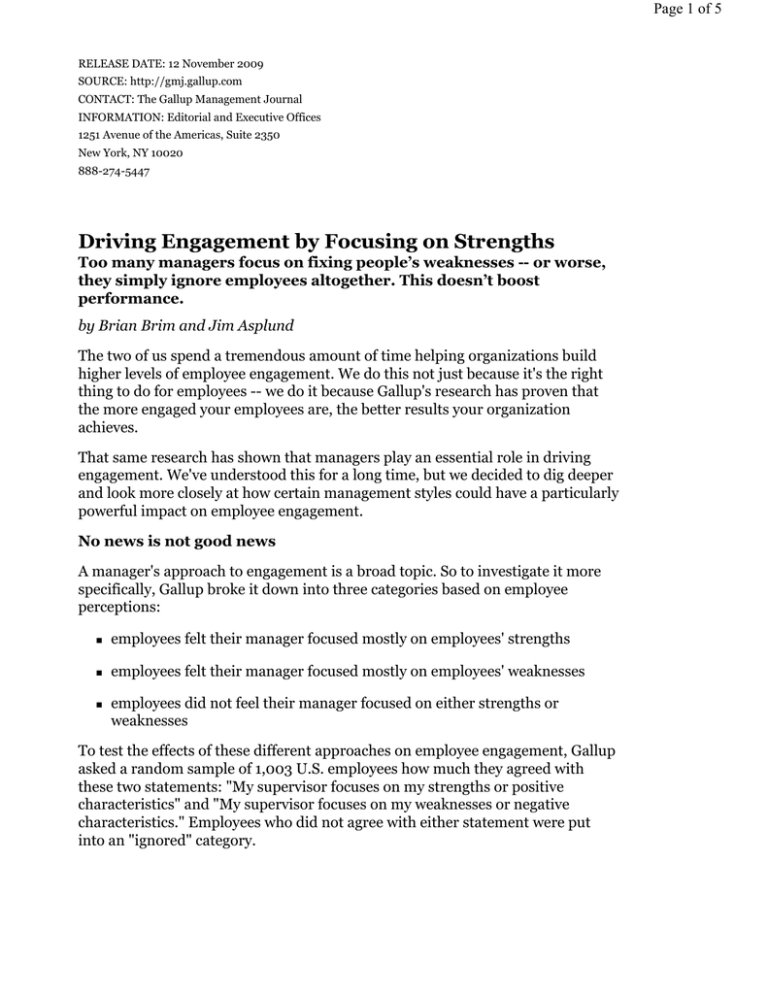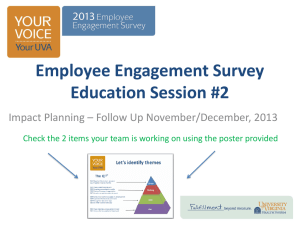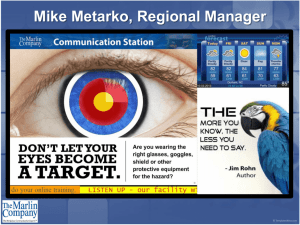Page 1 of 5
advertisement

Page 1 of 5 RELEASE DATE: 12 November 2009 SOURCE: http://gmj.gallup.com CONTACT: The Gallup Management Journal INFORMATION: Editorial and Executive Offices 1251 Avenue of the Americas, Suite 2350 New York, NY 10020 888-274-5447 Driving Engagement by Focusing on Strengths Too many managers focus on fixing people’s weaknesses -- or worse, they simply ignore employees altogether. This doesn’t boost performance. by Brian Brim and Jim Asplund The two of us spend a tremendous amount of time helping organizations build higher levels of employee engagement. We do this not just because it's the right thing to do for employees -- we do it because Gallup's research has proven that the more engaged your employees are, the better results your organization achieves. That same research has shown that managers play an essential role in driving engagement. We've understood this for a long time, but we decided to dig deeper and look more closely at how certain management styles could have a particularly powerful impact on employee engagement. No news is not good news A manager's approach to engagement is a broad topic. So to investigate it more specifically, Gallup broke it down into three categories based on employee perceptions: employees felt their manager focused mostly on employees' strengths employees felt their manager focused mostly on employees' weaknesses employees did not feel their manager focused on either strengths or weaknesses To test the effects of these different approaches on employee engagement, Gallup asked a random sample of 1,003 U.S. employees how much they agreed with these two statements: "My supervisor focuses on my strengths or positive characteristics" and "My supervisor focuses on my weaknesses or negative characteristics." Employees who did not agree with either statement were put into an "ignored" category. Page 2 of 5 We were disturbed to discover that a significant percentage of the respondents fit into the "ignored" category (25%). As you can see from the chart above, many U.S. managers ignore their employees, or so the employees perceive. Even more importantly, we found that if your manager focuses on your strengths, your chances of being actively disengaged at work are only 1 in 100. If your manager ignores you, though, you are about twice as likely to be actively disengaged at work than if your manager focuses on your weaknesses. Being overlooked, it seems, is more harmful to employees' engagement than having to discuss their weaknesses with their manager. Why is this important information for managers? Because employees who are ignored feel like they don't matter. There's a crucial phenomenon inherent in employee engagement: The best employees don't want to be coddled; they want to matter. They want to be part of something greater than themselves, and they want to know how they contribute to that something. They want to be heard, and above all, they do not want to be ignored. So although it seems counterintuitive, when managers focus on weaknesses rather than ignoring employees, those employees' chances of being engaged actually improve. That's because people prefer to get any feedback over no feedback at all -- even if that feedback is criticism. "I've worked with and for every type of manager represented in your data," said Page 3 of 5 Larry, a manager we met at a speaking engagement. "Bottom line: A manager who ignores employees is a person who has no business being in that role. People bother them. People are the 'nuisance' aspect of their job, so they ignore them as much as possible. If you are the kind of boss who ignores your employees, you shouldn't be a manager." We thought Larry had a key insight into managers who concentrate on weaknesses too. He believes that a lot of good managers fall into that category whether they want to or not. "I've worked in several companies that pushed managers to focus on people's negatives through a weakness-focused performance review process," he said. "These reviews might start out with what employees were doing well, but then the process forced the manager to look at 'areas of opportunity' -- a person's weaknesses -- for the majority of the review." What happens to employees and workgroups when companies force managers to take a weakness-fixing approach to employee development? The end result is likely to be a workgroup with a 2:1 ratio of engaged to actively disengaged employees. While a 2:1 ratio isn't great, it might not seem so bad when you consider that the ratio of engaged to actively disengaged employees is likely to be 1:20 when managers ignore employees. Leaving too many employees disengaged Gallup research shows that customers suffer when they are served by disengaged employees and consequently flee The result of focusing on weaknesses -- or in droves. worse yet, ignoring employees altogether -is striking, especially when it's considered in the context of an industrial-age model of management. In this model -- called "scientific management" by its main proponent, Frederick Winslow Taylor -- employees were treated very much like cogs in the wheel of a bigger machine, and their individual thoughts and talents were ignored in favor of rules and regulations put in place by management. This approach is reflected in Henry Ford's famous lament: "Why is it that every time I need a pair of hands, I get a human being as well?" The industrial age was followed by the knowledge age, and with it came the realization that employees' knowledge and understanding could bring value to organizations. This was a turn in the right direction, but many organizations still followed the outmoded industrial model in their approach to employee management and development. Because eliminating errors in manufacturing processes was so successful in achieving production efficiencies, many organizations tried to create similar processes for "fixing" their employees. After all, there are all sorts of things wrong with people. The ultimate goal of this approach was to remove employee "weaknesses." Page 4 of 5 But people aren't machines, and trying to fix them as if they were simply doesn't work. Yet many organizations persist in approaching employee development with the idea that fixing weaknesses creates the greatest gain. While this focus on fixing weaknesses may seem like an effective approach to engaging employees, Gallup data tell us that it only appears effective when it is compared to the terrible results managers achieve by ignoring their workers. Generally, Gallup suggests that a 4:1 ratio of engaged to actively disengaged employees is a reasonable starting point for companies that want to improve performance by increasing engagement. But as we mentioned above, a weaknessbased approach results in a 2:1 ratio of engaged to actively disengaged employees. So focusing on weaknesses results in an employee engagement ratio that's half the recommended starting point. More fundamentally, focusing on weaknesses still leaves 22% of employees actively disengaged. Having that many negative, hostile, or miserable employees severely limits what a manager -- or an organization -- can achieve. For example, Gallup research shows that customers suffer when they are served by disengaged employees and consequently flee in droves; disengaged employees drive up their company's costs. So a focus on weaknesses tends to drive down top-line revenues while simultaneously driving up costs. Ultimately the data show that managers who focus on the strengths of their employees create the strongest levels of engagement: These managers can achieve a 60:1 ratio of engaged to actively disengaged employees. Managers can reach that ratio when they realize that employees want to matter. And focusing on people's strengths is a crucial way to show them that they matter. Employees with managers who focus on their strengths begin to understand that they are unique and that they can contribute based on the talents that make them unique. They also understand that they are not just a cog in the wheel, but an important part of something greater than themselves. "A strengths-focused environment helps me think about becoming the best I can be based on the unique talents that I bring to my workplace," Larry said. "And that is a pretty engaging feeling." This feeling also generates superior performance. Teams with higher engagement levels have significantly higher productivity and profitability than workgroups with lower engagement levels. One great manager we know boiled this entire conversation down quite nicely: Ask your employees which manager they want to work for -- one who focuses on their strengths or one who focuses on their weaknesses. We're pretty sure which manager your employees would pick. But the big question for managers is this: Which kind of manager do you want to be? Brian Brim is a Principal of Global Client Education with Gallup. Learn More >> Jim Asplund is Chief Scientist, Strengths-Based Development and Principal, Performance Impact Consulting with Gallup. He is coauthor of Human Sigma: Page 5 of 5 Managing the Employee-Customer Encounter (Gallup Press, November 2007). Learn More >> Copyright © 2009 Gallup, Inc. All rights reserved. Gallup®, A8™, Business Impact Analysis™, CE11®, Clifton StrengthsFinder®, the 34 Clifton StrengthsFinder theme names, Customer Engagement Index™, Drop Club®, Emotional Economy™, Employee Engagement Index™, Employee Outlook Index™, Follow This Path™, Gallup Brain®, Gallup Consulting®, Gallup Management Journal®, GMJ®, Gallup Press®, Gallup Publishing™, Gallup Tuesday Briefing®, Gallup University®, HumanSigma®, I10™, L3™, PrincipalInsight™, Q12®, SE25™, SF34®, SRI®, Strengths Spotlight™, StrengthsBased Selling™, StrengthsCoach™, StrengthsFinder®, StrengthsQuest™, TeacherInsight™, The Gallup Path®, and The Gallup Poll® are trademarks of Gallup, Inc. All other trademarks are the property of their respective owners. These materials are provided for noncommercial, personal use only. Reproduction prohibited without the express permission of Gallup, Inc.



